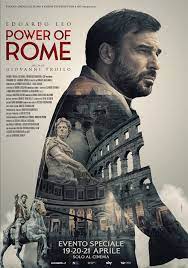
POWER OF ROME
Italy, 2022, 83 minutes, Colour.
Eduardo Leo.
Directed by Giovanni Troilo.
The Power of Rome has been well known and acclaimed for more than 2500 years. The power has been political. The power has been ecclesiastical.
Here is an 80 minutes opportunity for the audience to reflect on this history, this power, the exercise of power and its consequences, some of the key personalities involved, some of the significant buildings still standing in the city.
Response to this film will depend on audience knowledge about Rome and its history, knowledge from history books, from the movies, rather than actually having visited the city. For those who have visited the city, for those who have lived there, it is an opportunity for reflection and rumination, wondering why this person, this event, this building was highlighted rather than others.
And this invitation to reflect comes from the style of the film, not a straightforward documentary. Rather, it is a variation on the docudrama. And the framework, and constant reference, is to making movies about Rome – and this particular case, an opening on the ides of March with the conspirators and Brutus about to stab Caesar and the actor objecting, halting the scene to the director’s frustration, speculating on what would have happened had season not been killed. Would there have been a Roman Empire? And the role of Augustus?
The actor, Eduardo Leo, takes time off to wander around the city, to observe, to think. And, as he does so, the filmmakers provide some historical re-creations, Marc Anthony reciting his Shakespearean speech about burying Caesar, sequences about Nero, his madness, the influence of his mother, the burning of Rome, the initial conflict between Romulus and Remus, gladiator fights…
And the film spends a lot of time at the Coliseum, giving its history, contemporary guides explaining the history to tourists, the power of bread and circuses for the masses, and the dedication of the Coliseum by Titus. There is also some time spent at the Pantheon and its place in Roman history.
And, there is the role of Christianity, the survival of Christians during several centuries of persecuting attitudes, until the coming of Constantine, his vision of the cross, his shrewd political sense about only one God worshipped in the Empire. And there are some scenes of his mother, Helena, going to Jerusalem in search for relics – and the comment that she raised veneration of the Virgin Mary from a small devotion to a key component of Christianity. And, there is St Peter’s, looking larger, grander than it often does, and the inclusion of some clips of the filming of workers on the dome, quite vertiginous for the viewer!
And, the continual references to the movies, to Ben Hur, to the making of Quo Vadis, to Christopher Plummer in The Fall of the Roman Empire, a visit behind the scenes at Cinecitta, props, long corridors of costumes… – and, as the actor travels around Rome on a motorcycle with the production assistant, references to Audrey Hepburn and Gregory Peck!
No real conclusions (except that the actor goes back and allows Caesar to be stabbed), just verbal and visual stimuli to reflect on Rome and its past power – with no compliments for contemporary Rome. During the final credits, on the left side of the screen, there is a continual running list of significant dates.